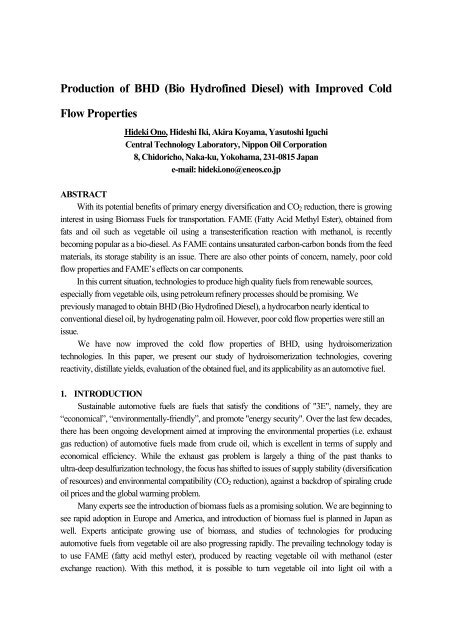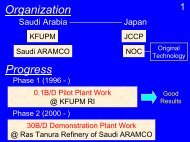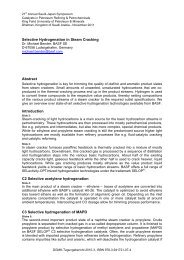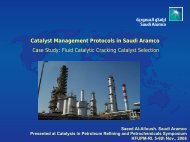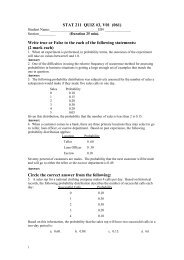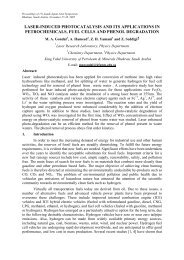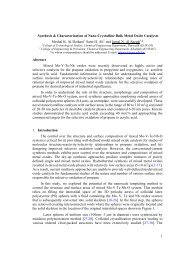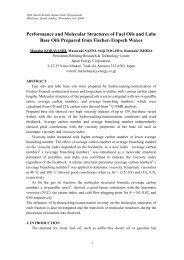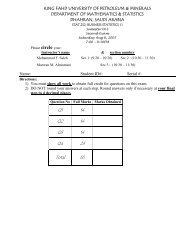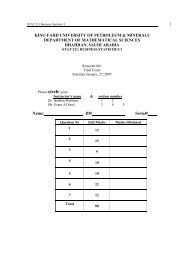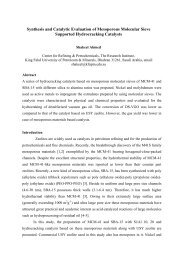Production of BHD (Bio Hydrofined Diesel) with Improved Cold Flow ...
Production of BHD (Bio Hydrofined Diesel) with Improved Cold Flow ...
Production of BHD (Bio Hydrofined Diesel) with Improved Cold Flow ...
Create successful ePaper yourself
Turn your PDF publications into a flip-book with our unique Google optimized e-Paper software.
<strong>Production</strong> <strong>of</strong> <strong>BHD</strong> (<strong>Bio</strong> Hydr<strong>of</strong>ined <strong>Diesel</strong>) <strong>with</strong> <strong>Improved</strong> <strong>Cold</strong><br />
<strong>Flow</strong> Properties<br />
Hideki Ono, Hideshi Iki, Akira Koyama, Yasutoshi Iguchi<br />
Central Technology Laboratory, Nippon Oil Corporation<br />
8, Chidoricho, Naka-ku, Yokohama, 231-0815 Japan<br />
e-mail: hideki.ono@eneos.co.jp<br />
ABSTRACT<br />
With its potential benefits <strong>of</strong> primary energy diversification and CO 2 reduction, there is growing<br />
interest in using <strong>Bio</strong>mass Fuels for transportation. FAME (Fatty Acid Methyl Ester), obtained from<br />
fats and oil such as vegetable oil using a transesterification reaction <strong>with</strong> methanol, is recently<br />
becoming popular as a bio-diesel. As FAME contains unsaturated carbon-carbon bonds from the feed<br />
materials, its storage stability is an issue. There are also other points <strong>of</strong> concern, namely, poor cold<br />
flow properties and FAME’s effects on car components.<br />
In this current situation, technologies to produce high quality fuels from renewable sources,<br />
especially from vegetable oils, using petroleum refinery processes should be promising. We<br />
previously managed to obtain <strong>BHD</strong> (<strong>Bio</strong> Hydr<strong>of</strong>ined <strong>Diesel</strong>), a hydrocarbon nearly identical to<br />
conventional diesel oil, by hydrogenating palm oil. However, poor cold flow properties were still an<br />
issue.<br />
We have now improved the cold flow properties <strong>of</strong> <strong>BHD</strong>, using hydroisomerization<br />
technologies. In this paper, we present our study <strong>of</strong> hydroisomerization technologies, covering<br />
reactivity, distillate yields, evaluation <strong>of</strong> the obtained fuel, and its applicability as an automotive fuel.<br />
1. INTRODUCTION<br />
Sustainable automotive fuels are fuels that satisfy the conditions <strong>of</strong> "3E", namely, they are<br />
“economical”, “environmentally-friendly”, and promote "energy security". Over the last few decades,<br />
there has been ongoing development aimed at improving the environmental properties (i.e. exhaust<br />
gas reduction) <strong>of</strong> automotive fuels made from crude oil, which is excellent in terms <strong>of</strong> supply and<br />
economical efficiency. While the exhaust gas problem is largely a thing <strong>of</strong> the past thanks to<br />
ultra-deep desulfurization technology, the focus has shifted to issues <strong>of</strong> supply stability (diversification<br />
<strong>of</strong> resources) and environmental compatibility (CO 2 reduction), against a backdrop <strong>of</strong> spiraling crude<br />
oil prices and the global warming problem.<br />
Many experts see the introduction <strong>of</strong> biomass fuels as a promising solution. We are beginning to<br />
see rapid adoption in Europe and America, and introduction <strong>of</strong> biomass fuel is planned in Japan as<br />
well. Experts anticipate growing use <strong>of</strong> biomass, and studies <strong>of</strong> technologies for producing<br />
automotive fuels from vegetable oil are also progressing rapidly. The prevailing technology today is<br />
to use FAME (fatty acid methyl ester), produced by reacting vegetable oil <strong>with</strong> methanol (ester<br />
exchange reaction). With this method, it is possible to turn vegetable oil into light oil <strong>with</strong> a
consistency similar to diesel oil. FAME is mixed <strong>with</strong> diesel and used to fuel diesel vehicles, mainly<br />
in Europe. But due to its poor oxidative stability, FAME can only be mixed <strong>with</strong> diesel in limited<br />
quantities; what are needed are biomass fuels <strong>with</strong> properties superior to FAME.<br />
We previously managed to obtain <strong>BHD</strong> (<strong>Bio</strong> Hydr<strong>of</strong>ined <strong>Diesel</strong>), a hydrocarbon very similar to<br />
conventional diesel oil, by hydrogenating palm oil. <strong>BHD</strong> has superior oxidation stability compared to<br />
FAME. However, poor cold flow properties were still an issue. The production <strong>of</strong> <strong>BHD</strong> from palm<br />
oil will be described in the second section. In this study, we isomerized <strong>BHD</strong> to improve its cold flow<br />
properties. Details <strong>of</strong> these examinations will be presented in the third section.<br />
2. PRODUCTION OF <strong>BHD</strong> FROM PALM OIL<br />
2.1 Hydrogenation conditions<br />
The feed oil was pretreated (decolorized, degummed, etc.), purified palm oil. The properties <strong>of</strong><br />
the feed oil are shown in Table 1. Reaction temperature: 240–360°C; reaction pressure: 3-10 MPa;<br />
LHSV: 0.5 h -1 . A hydrodesulfurization catalyst common in petroleum refining was used.<br />
Table 1<br />
Properties <strong>of</strong> the Feed Oil<br />
Purified Palm Oil<br />
Density g/cm3 0.9159<br />
Higher Calorific Value MJ/kg 39.5<br />
Carbon mass% 77.0<br />
Hydrogen mass% 11.5<br />
Oxygen mass% 11.4<br />
Nitrogen mass%
100<br />
Component Ratio ,%<br />
80<br />
60<br />
40<br />
20<br />
C18<br />
C16<br />
C18<br />
C17<br />
C16<br />
0<br />
Alkyl Chain<br />
<strong>of</strong> Palm Oil<br />
Hydrogenated<br />
Palm Oil (280℃)<br />
C15<br />
Hydrogenated<br />
Palm Oil (320℃)<br />
Fig. 1<br />
Carbon Number <strong>of</strong> Hydrogenated Palm Oil (<strong>BHD</strong>)<br />
This is thought to be caused by the progression <strong>of</strong> decarbonation in the hydrodeoxygenation<br />
reaction. That is, in the decarbonation reaction, oxygen is eliminated in the form <strong>of</strong> CO 2 , and thus the<br />
carbon number <strong>of</strong> the hydrogenated oil decreases by one, and straight chain hydrocarbons <strong>of</strong> C15 and<br />
C17 are formed (Fig. 2). The proportion <strong>of</strong> C15 and C17 increases as the reaction temperature rises,<br />
that is, decarbonation selectivity increases as the reaction temperature rises in the hydrogenation <strong>of</strong><br />
palm oil. Looking at the effects <strong>of</strong> pressure, we found that decarbonation selectivity increases as<br />
pressure becomes lower (Fig. 3).<br />
Vegetable Oil<br />
Palm Oil:<br />
R=C15, C17<br />
RCOOCH 2<br />
RCOOCH<br />
RCOOCH 2<br />
Fatty Acid<br />
Glycerin<br />
+12H 2<br />
Dehydration<br />
+3H 2<br />
Decarbonation<br />
3 R-CH 3 6H 2 O 3 R-H 3 CO 2<br />
CH 3 -CH 2 -CH 3<br />
CH 3 -CH 2 -CH 3<br />
Fig. 2<br />
Scheme <strong>of</strong> Hydrodeoxygenation Reaction
Decarbonation Selectivity,%<br />
50<br />
40<br />
30<br />
20<br />
10<br />
0<br />
3MPa<br />
6MPa<br />
100 200 300 400<br />
Reaction Temperature,℃<br />
Fig. 3<br />
Reaction temperature and decarbonation selectivity<br />
From Fig. 2, it can be seen that the decarbonation reaction requires less hydrogen than the<br />
dehydration reaction, for the same amount <strong>of</strong> deoxygenation. Also, decarbonation is less <strong>of</strong> an<br />
exothermal reaction than dehydration. Therefore, reaction conditions <strong>of</strong> high decarbonation selectivity<br />
are better from the standpoint <strong>of</strong> the suppression <strong>of</strong> hydrogen consumption and exothermicity.<br />
However, when decarbonation selectivity increases, the carbon number <strong>of</strong> the produced hydrocarbon<br />
decreases and gas oil yields decrease, and carbon dioxide emissions increase; these are disadvantages.<br />
When designing a process <strong>of</strong> <strong>BHD</strong> production, we should consider all <strong>of</strong> these aspects.<br />
2.3 Test run using <strong>BHD</strong><br />
We conducted a field test using an actual vehicle, whose fuel contained <strong>BHD</strong> produced by the<br />
method stated above. The test was conducted from October 2007 to March 2008 in collaboration <strong>with</strong><br />
the Tokyo government, Toyota and Hino. The field test was completed <strong>with</strong> no problems. The details<br />
<strong>of</strong> the test are described in the paper; "Verification Test <strong>of</strong> <strong>Bio</strong> Hydr<strong>of</strong>ined <strong>Diesel</strong> by Tokyo City<br />
Hybrid Bus" JSAE 20085928.<br />
2.4 Comparison between <strong>BHD</strong> and FAME<br />
The accelerated oxidation test results for <strong>BHD</strong> and FAME are shown in Table 4. Oxygen was<br />
bubbled through the oil for 16 hours at 115°C. Acid numbers were measured before and after the test.<br />
Compared to FAME, <strong>BHD</strong> showed a much smaller acid number increase in the accelerated<br />
oxidization test, confirming its superior oxidation stability. This is because the oil’s unsaturated bonds<br />
have been hydrogenated, and we can say that this allays concerns currently held about problems <strong>with</strong><br />
FAME use.<br />
Table 4<br />
Oxidation Stability <strong>of</strong> <strong>BHD</strong> and FAME
Acid Number<br />
(before test)<br />
Acid Number<br />
(after test)<br />
Palm<br />
<strong>BHD</strong><br />
Palm<br />
FAME<br />
Conventional<br />
<strong>Diesel</strong> Oil<br />
mgKOH/g 0.00 0.26 0.00<br />
mgKOH/g 0.03 10.40 0.07<br />
The cold flow properties <strong>of</strong> the <strong>BHD</strong> are shown in Table 5. The cloud point <strong>of</strong> the <strong>BHD</strong> is about<br />
20°C, slightly worse than FAME. Cloud point is the temperature at which wax (paraffin) begins to<br />
separate when and oil is chilled to a low temperature, and it serves as an important indicator <strong>of</strong><br />
practical performance in automotive applications in low temperatures. The cloud point <strong>of</strong> <strong>BHD</strong><br />
(20°C) is much higher than the value prescribed in the JIS (Japan Industrial Standard) standard, and<br />
thus <strong>BHD</strong> cannot be used by itself in winter.<br />
Table 5<br />
<strong>Cold</strong> <strong>Flow</strong> Properties <strong>of</strong> <strong>BHD</strong><br />
Palm<br />
<strong>BHD</strong><br />
Palm<br />
FAME<br />
Conventional<br />
<strong>Diesel</strong> Oil<br />
Cloud Point ℃ 20 15 -6<br />
Pour Point ℃ 20.0 12.5 -30.0<br />
CFPP ℃ 22 11 -9<br />
This poor low-temperature performance is due to the fact that hydrogenated oil is a straight chain<br />
hydrocarbon (normal paraffin). In the field test, the fuel contained only 10% <strong>BHD</strong>, and its cold flow<br />
properties were acceptable. However, the poor cold flow properties <strong>of</strong> <strong>BHD</strong> are an issue when we<br />
increase the <strong>BHD</strong> content or use the <strong>BHD</strong>-blended diesel in very cold areas. In order to improve the<br />
cold flow properties <strong>of</strong> <strong>BHD</strong>, we isomerized <strong>BHD</strong> (normal paraffin) into iso-paraffin, which has<br />
branched chains in its molecular structure. In the next section, we discuss the examinations.<br />
3. ISOMERIZATION OF <strong>BHD</strong><br />
3.1 Isomerization conditions<br />
We conducted reaction experiments involving <strong>BHD</strong> isomerization using our pilot plants. The<br />
feed <strong>BHD</strong> was made using the method described in the second section. Two kinds <strong>of</strong> noble metal<br />
catalysts (amorphous type and zeolite type) were used. Reaction temperature: 300°–340°C; reaction<br />
pressure: 3-10 MPa; LHSV: 1 h -1 .<br />
3.2 Compositions <strong>of</strong> isomerization products<br />
Typical compositions <strong>of</strong> isomerization products are shown in Fig. 5. Feed <strong>BHD</strong> is isomerized into<br />
iso-paraffin and simultaneously cracked into light fractions whose carbon numbers are lower than<br />
C14. This means that the gas oil fraction will decrease as we proceed <strong>with</strong> the isomerization reaction,<br />
which is necessary to improve cold flow properties. Therefore, when we design the process <strong>of</strong> <strong>BHD</strong>
isomerization, we should select a reaction system which has moderate isomerization and minimal<br />
cracking.<br />
Compositions, mass%<br />
100<br />
90<br />
80<br />
70<br />
60<br />
50<br />
40<br />
30<br />
20<br />
10<br />
0<br />
Feed <strong>BHD</strong> 300℃ 320℃<br />
Gas+Nap<br />
C11-C14<br />
isoC15<br />
isoC16<br />
isoC17<br />
isoC18<br />
nC15<br />
nC16<br />
nC17<br />
nC18<br />
Fig. 5<br />
Catalyst : Zeolite Type<br />
Compositions <strong>of</strong> Isomerization Products<br />
We compared the reactivity <strong>of</strong> two catalysts, one being zeolitic and the other amorphous. The<br />
activity <strong>of</strong> the zeolitic catalyst was higher than that <strong>of</strong> the amorphous type (Fig. 6).<br />
Feed Conversion, mass%<br />
100<br />
80 Zeolite Type<br />
60<br />
40<br />
20<br />
Amorphous Type<br />
0<br />
290 300 310 320 330 340 350<br />
Reaction Temperature, ℃<br />
Fig. 6<br />
Activity <strong>of</strong> two kinds <strong>of</strong> catalyst<br />
Focusing on the relation between isomerization and cracking, we compared cracking ratios at the<br />
same isomerization ratio (Fig. 7). The amorphous catalyst had a lower cracking ratio in the low<br />
conversion region, but the zeolitic catalyst had a lower cracking ratio in the high conversion region.
Cracking Ratio, mass%<br />
40<br />
35<br />
30<br />
25<br />
20<br />
15<br />
10<br />
5<br />
0<br />
Amorphous Type<br />
Zeolite Type<br />
0 20 40 60 80 100<br />
Isomerization Ratio, mass%<br />
Fig. 7<br />
Relationship between Isomerization and Cracking<br />
The relationship between reaction pressure and feed conversion is shown in Fig. 8. Activity is<br />
higher under low pressure conditions. It is thought that this is because dehydrogenation <strong>of</strong> normal<br />
paraffin, which is the origin <strong>of</strong> the isomerization reaction, occurs more readily at lower pressure.<br />
Feed Conversion, %<br />
Fig. 8<br />
100<br />
80<br />
60<br />
40<br />
20<br />
0<br />
3MPa<br />
6MPa<br />
10MPa<br />
280 300 320 340 360<br />
Reaction Temperature, ℃<br />
Relationship between Reaction Pressure and Feed Conversion<br />
3.3 Properties <strong>of</strong> isomerization products<br />
Table 6 shows the properties <strong>of</strong> the isomerized <strong>BHD</strong> (isomerization ratio: 50%), which was made<br />
by distilling <strong>of</strong>f the fraction lighter than 185°C. The isomerized <strong>BHD</strong> has greatly improved cold flow<br />
properties compared to the normal <strong>BHD</strong>. The cetane number was slightly lower after isomerization,<br />
but the isomerized <strong>BHD</strong> still has a cetane number higher than that <strong>of</strong> conventional diesel oil, and<br />
should have good ignition properties.<br />
Table 6<br />
Properties <strong>of</strong> Isomerized <strong>BHD</strong>
Isomerized <strong>BHD</strong> <strong>BHD</strong><br />
Density 15℃ g/cm3 0.781 0.783<br />
Viscosity 30℃ mm2/s 3.9 4.1<br />
Pour Point ℃ +5.0 +20.0<br />
Cloud Point ℃ +4 +21<br />
Cetane Number 90.3 101<br />
3.4 Property <strong>of</strong> isomerized <strong>BHD</strong>-blended diesel oil<br />
The isomerized <strong>BHD</strong> described in Table 6 was blended <strong>with</strong> conventional diesel oil, and a variety<br />
<strong>of</strong> mixtures were evaluated. As shown in Table 7, the cold filter plug point (CFPP) <strong>of</strong> diesel oil<br />
containing isomerized <strong>BHD</strong> was lower than that <strong>of</strong> normal <strong>BHD</strong>, even when the isomerized <strong>BHD</strong><br />
content is 20 vol%. Looking at the cetane index, isomerized <strong>BHD</strong>-blended diesel has a lower cetane<br />
index than normal <strong>BHD</strong>-blended diesel in the case <strong>of</strong> the 10 vol% blend. However, the blend<br />
containing 20 vol% isomerized <strong>BHD</strong> had a cetane index the same as that <strong>of</strong> the 10 vol% normal<br />
<strong>BHD</strong> blend. We found that a diesel oil which contains 20 vol% <strong>of</strong> isomerized <strong>BHD</strong> (isomerization<br />
ratio: 50%) would have properties as good or better than those <strong>of</strong> conventional diesel oil.<br />
Table 7<br />
Properties <strong>of</strong> Isomerized <strong>BHD</strong>-Blended <strong>Diesel</strong> Oil<br />
Normal <strong>BHD</strong> 50% Isomerized <strong>BHD</strong> Conventional<br />
<strong>BHD</strong> Content 10vol% 10vol% 20vol% <strong>Diesel</strong> Fuel<br />
Density g/cm3 0.8103 0.8198 0.8140 0.8283<br />
Viscosity mm2/s 2.828 3.330 3.250 3.254<br />
Distillation T90 ℃ 326.0 330.0 324.5 337.5<br />
CFPP ℃ -10 -14 -12 -9<br />
Cetane index 62.0 58.2 61.3 58.1<br />
4. CONSIDERATION<br />
Through the reaction experiments involving <strong>BHD</strong> isomerization, we were able to obtain<br />
isomerized <strong>BHD</strong>, and showed that the isomerization ratio can be controlled over a wide range<br />
through careful selection <strong>of</strong> the catalysts and reaction conditions. In <strong>BHD</strong> isomerization, the cracking<br />
reaction occurs as a sub reaction. It is important to select a catalyst system and reaction conditions that<br />
minimize cracking, while staying <strong>with</strong>in a range in which the isomerization ratio is sufficient.<br />
Isomerization improved the cold flow properties <strong>of</strong> <strong>BHD</strong>, and expanded the range <strong>of</strong> usable <strong>BHD</strong><br />
blend ratios. One <strong>of</strong> the advantages <strong>of</strong> <strong>BHD</strong> is a high cetane number. Isomerization does not cause a<br />
major decline in cetane number, meaning that isomerized <strong>BHD</strong> still has the same advantage.<br />
Palm oil and other vegetable oils (rapeseed, sunflower, soybean, corn, etc.) are used as cooking<br />
oils all over the world. If these oils are to be used for automotive fuels, it will probably not happen by<br />
getting people to use less for cooking. And if we simply increase cultivation, there is a risk <strong>of</strong> serious<br />
environmental destruction. We need to thoroughly consider how sources <strong>of</strong> raw materials can be
secured, also looking at the use <strong>of</strong> non-edible vegetable oils such as Jatropha oil and algae oil.<br />
5. CONCLUSION<br />
In our study <strong>of</strong> <strong>BHD</strong> production (hydrogenation <strong>of</strong> palm oil) and <strong>BHD</strong> isomerization, the<br />
following things became clear.<br />
a) By hydrogenating palm oil, it is possible to obtain from vegetable oil a hydrocarbon nearly equal<br />
in many respects to conventional diesel oil.<br />
b) <strong>BHD</strong> is a straight chain hydrocarbon derived from the alkyl chains <strong>of</strong> the vegetable oil.<br />
c) <strong>BHD</strong> has higher oxidation stability than FAME.<br />
d) A 14,000 km test run using an actual vehicle car was conducted using diesel oil which contained<br />
10% <strong>BHD</strong>.<br />
e) It is possible to produce isomerized <strong>BHD</strong> whose iso-paraffin content is controllable.<br />
f) Isomerization greatly improved the cold flow properties <strong>of</strong> <strong>BHD</strong>.<br />
g) <strong>BHD</strong> isomerization increases the range <strong>of</strong> usable blend ratios for <strong>BHD</strong> <strong>with</strong> diesel oil.<br />
h) A diesel oil containing 20% isomerized <strong>BHD</strong> shows properties nearly the same as those <strong>of</strong><br />
conventional diesel oil.<br />
6. REFERENCE<br />
1) "Verification Test <strong>of</strong> <strong>Bio</strong> Hydr<strong>of</strong>ined <strong>Diesel</strong> by Tokyo City Hybrid Bus" JSAE 20085928


